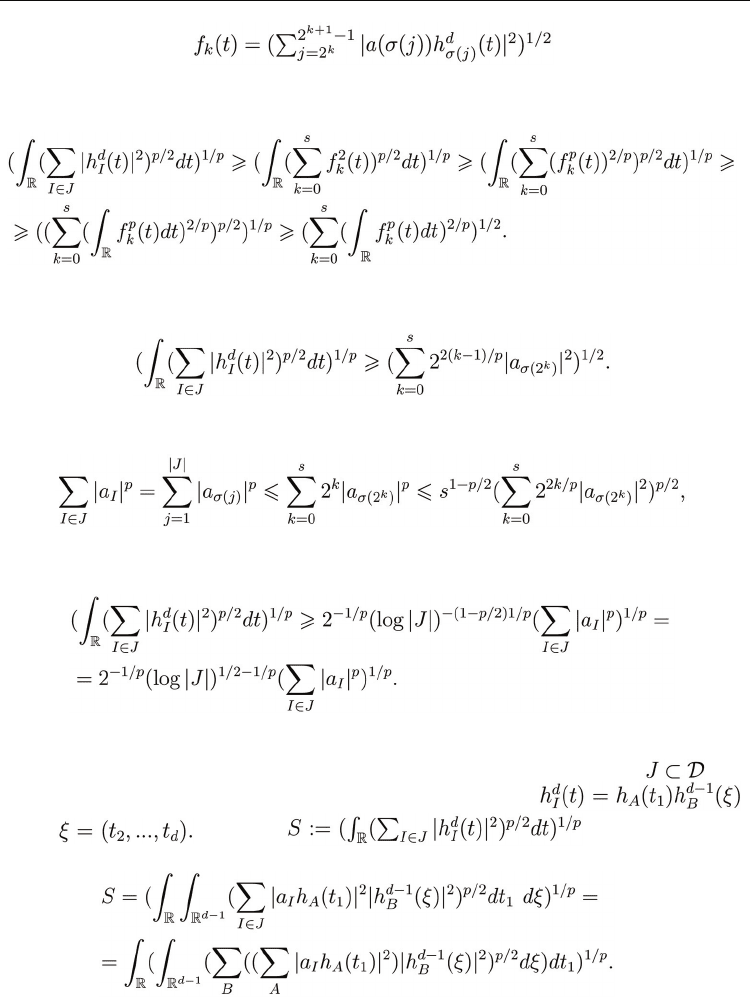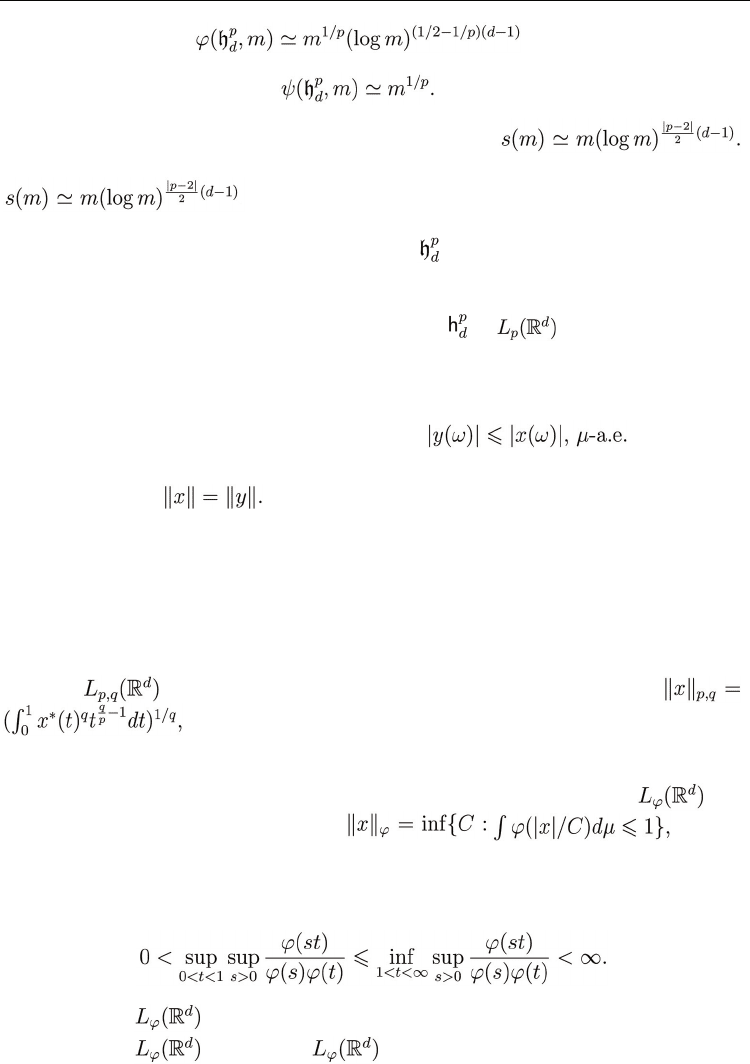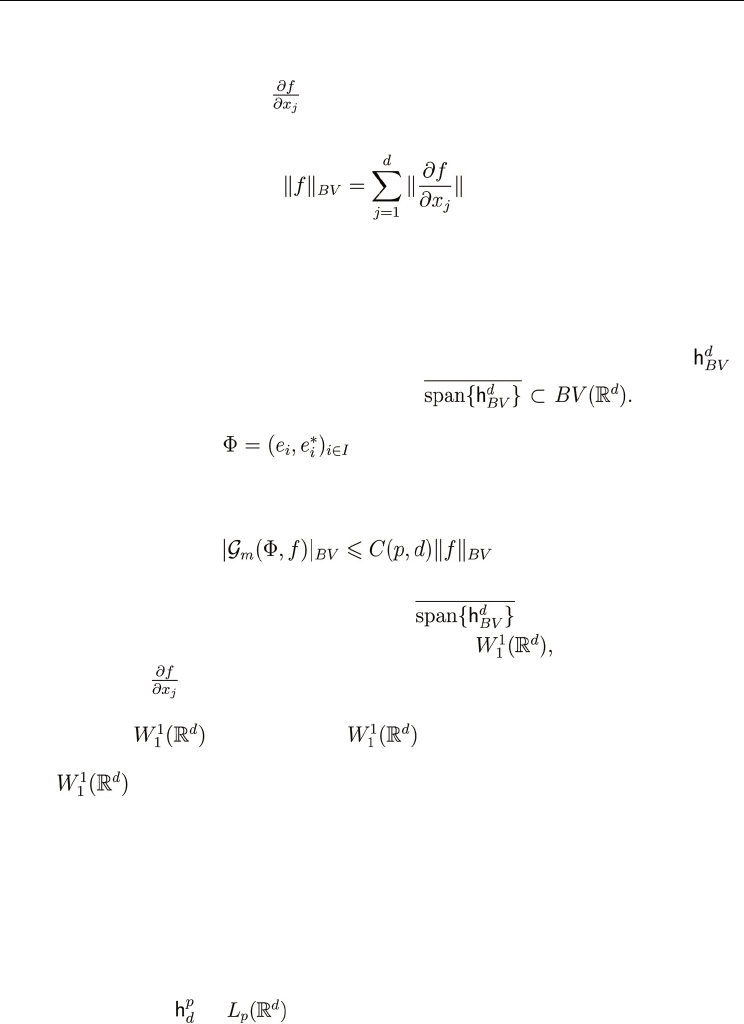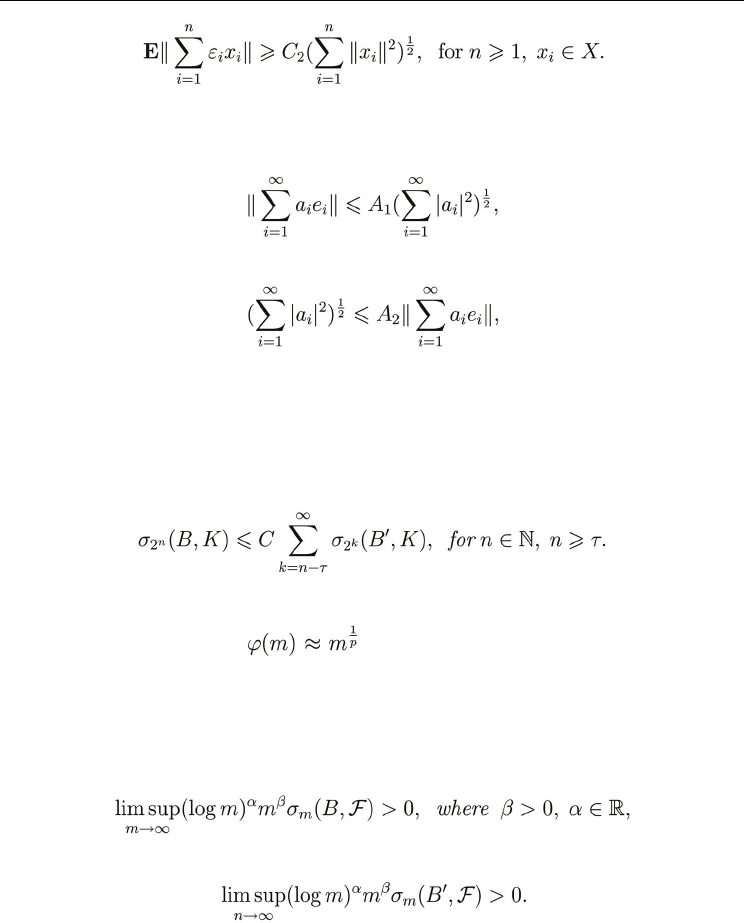Bednorz W. (ed.) Advances in Greedy Algorithms
Подождите немного. Документ загружается.


Greedy Type Bases in Banach Spaces
341
for some constant C(d) < ∞ and
depending on t. Thus
It shows that is comparable with which in the view of
Proposition 4 completes the proof.
■
The second result shows that
is not greedy in L
p
. We recall that for as system,
we have
used intervals I ∈ D
d
as the indices. We first prove the following:
Proposition 5 For d = 1, 2, … and 1 < p < ∞ in
we have
(24)
for p ≤ 2, and
(25)
Proof. The right hand side inequality in (24) is easy. We simply apply the Holder inequality
with exponent
to the inside sum and we get
(26)
To show the left hand side we will need the following result:
Lemma 3 For d = 1 and 1 ≤ p < ∞ and for any finite subset
we have
Proof. Let us denote From the definition of the Haar system we
obtain that
so
■
Now we fix d = 1 and 1 < p ≤ 2. Let
be such that is a
decreasing sequence. Fix s such that
and we put

Advances in Greedy Algorithms
342
Then
Hence using Lemma 3 we obtain that
Since
we derive
Therefore we have established (24) for d = 1. We turn to show the left hand side inequality in
(24) by induction on d. Suppose we have (24) valid for d-1. Given a finite set
d
we
write each I ∈ J as I = A × B with A ∈ D and B ∈ D
d-1
and then
where
We denote and estimate
(27)
For each t
1
we apply the inductive hypothesis (note that the number of different B’s is at
most J) and we continue the estimates

Greedy Type Bases in Banach Spaces
343
(28)
Now we apply the estimate (24) for d = 1 and we continue as
(29)
Due to Proposition 4 we can complete the proof of (24). The inequality (25) follows by
duality from (24) for 1 < p ≤ 2.
■
Note that if we work in the setting where all a
I
= 1, then actually one can show, using
Lemma 3, that for d = 1,
is just comparable with │J│
1/p
. Therefore we can start
the induction from d = 2 and thus derive:
Proposition 6 For d = 1, 2, … and 1 < p ≤ 2 in we have
(30)
for 2 ≤ p < ∞, and
(31)
The inequalities (30) and (31) finally lead to the main result for
systems which was
conjectured in [32] and proved in [35].
Theorem 9 Suppose that for 1 < p < ∞ we consider the system in space. Then
(32)
Proof. Proposition 6 combined with Theorem 2 shows that
The estimate from below was proved in [32].
■
Corollary 2 For d = 1, 2, … and 2 < p < ∞ in
we have
(33)
(34)
whereas for p ≤ 2

Advances in Greedy Algorithms
344
(35)
(36)
Note that Corollary 2 implies that (7) is verified with
Consequently we deduce from Theorem 3 that for a given x ∈ X there exist
coefficients from which we should choose m to find near best
m-term approximation. Therefore it seems to be intriguing problem to find the algorithm
which provides the near optimal approximation for
5.4 Haar systems in other spaces
One could expect that if there exists the Haar system
in the same construction
should work in rearrangement spaces. We recall that that a rearrangement invariant space is
a Banach space (X, &· &) whose elements are measurable functions on measure space (Ω, μ)
satisfying the following conditions
1. if x ∈ X and y is a measurable function such that
2. if x ∈ X and y has the same distribution as x, i.e. for all λ ∈ R we have μ(x ≤ λ) = μ(y ≤ λ)
then y ∈ X and
The main result of [42] states that L
p
are the only rearrangement spaces for which the
normalized Haar system is greedy.
Theorem 10 Let X be a rearrangement invariant space on [0, 1]
d
. If a Haar system h
d
normalized in
X is a greedy basis in X, then X = L
p
[0, 1]
d
for some 1 < p < ∞.
On the other hand there are examples of bizzare rearrangement spaces (see [20]) for which
there exists some greedy basis. However it was conjectured in [42] that for classical different
from L
p
rearrangement spaces (e.g. Lorentz, Orlicz) this is not possible. We recall that
Lorentz is a Lorentz rearrangement space with the norm
where x* is non-increasing rearrangement of x (uniquely
determined). It was shown in [42] that if for p ≠ q there exists greedy basis in L
p,q
, then it has
rather unusual properties.
The second interesting class of examples comprise Orlicz spaces. We recall that is an
Orlicz rearrangement space with the norm where
ϕ
is some convex, increasing,
ϕ
(0) = 0 function. Such spaces where analyzed recently in [16]
where some extension of Theorem 10 has been proved. We say that space has non-trivial
Boyd indices if
Theorem 11 Let be an Orlicz spaces with non-trivial Boyd indices. An wavelet basis
is democratic in
if and only if = L
p
(R
d
) for some 1 < p < ∞.

Greedy Type Bases in Banach Spaces
345
5.5 Functions of bounded variations
Let Ω ⊂ R
d
be an open subset. Let us recall that a function f ∈ L
1
(Ω) has bounded variation if
all its distributional derivatives
are measures of bounded variation. The space of all
such functions equipped with the norm
is denoted by BV (Ω). This function space is of importance for the geometric measure theory,
calculus of variation, image processing and other areas. Clearly whenever &f&
BV
< ∞ then
f ∈ L
p
, where p = d/(d - 1) by the classical embedding theorems. Observe that BV (R
d
) is a
non separable space so it cannot have any countable system satisfying (4). On the other hand
one may ask whether the Haar system normalized to BV (R
d
) (which we denote by
)
has some stability property, i.e. is quasi greedy on
Generalizing
some of the previous results (e.g. [7],[36],[41]) it was proved in [5] that the following holds:
Theorem 12 Suppose that is a normalized wavelet basis generated by some
compactly supported scaling function (see our discussion in Section about Haar Systems). Then if
f ∈ BV (R
d
), d ≥ 2 the following inequality holds
(37)
for some constant C(p, d) depending on p, d only.
This is however not much satisfactory result since
is not a very natural space.
A natural separable space of BV (R
d
) is the Sobolev space i.e. the space of all f ∈
BV (R
d
) such that are absolutely continuous measures for j = 1, 2, …, d. A natural and
interesting problem which rises in this context is to find a smooth wavelet basis which is
quasi greedy in
. We remark that does not have unconditional basis, so it
does not have a greedy basis. On the other hand an immediate consequence of Theorem 13
is that
has a quasi greedy basis.
6 Examples of greedy and quasi greedy bases
In this section we provide a class of basic examples for natural systems which share the
greedy or quasi greedy property.
6.1 Greedy bases
There to basic examples of greedy bases which we often refer to:
1. the natural basis in l
p
, p ≥ 1;
2. the Haar system
for .
It occurs that these natural systems can be useful when combined with some theoretical
methods of producing greedy bases.

Advances in Greedy Algorithms
346
The first approach is based on the fact that being greedy (or quasi greedy) is an isomorphic
property. Therefore whenever
is a greedy system in Banach space X and T : X → Y
is a linear isomorphism, then
is a greedy system in Y. We mention two
practically useful examples of this remark:
1. Consider L
p
, 1 < p < ∞ space. If B is a good wavelet basis (cf. [37] Theorem 8.13)
normalized to L
p
then it is equivalent to the Haar system h
p
. Thus such all systems are
greedy.
2. It is known (cf. [37], Chapter 9) that good wavelet bases in Besov space when
properly normalized are equivalent to the unit vector basis in l
p
, thus greedy for 1 ≤ p <
∞.
The second approach is to use the dual basis (see Remark 3). In particular (see Corollary 1) we
have shown that dual basis of
in L
p
, 1 < p < ∞ is greedy in L
q
, were 1/p+1/q =1. However one
has to be careful when using Remark 3, since without the additional assumption that
for some 0 < < 1 it may be not true that dual basis is greedy in its linear
closure. The simplest example of such a case may be constructed for the system
in H
1
(the
space of integrable functions with the norm given by (23)). The dual system is the system
considered in the space VMO. It was proved in [29] that in the space
VMO, so we have a natural example of a greedy system whose dual is not greedy. Actually
one can show that the space VMO does not have any greedy system.
Now we turn to discuss other examples of greedy bases in L
p
. The simplest case is of p = 2,
i.e. when we consider Hilbert space. Clearly every orthonormal basis, and more generally,
every Riesz basis is greedy in a Hilbert space, since they are the only unconditional systems
in L
2
. This easily follows from Proposition 4.
In L
p
for 1 < p < ∞ , p ≠2, the situation is not as simple. Except wavelet bases it is a hard
question to provide other examples of greedy bases. We state below the Kamont [23]
construction of a generalized Haar system in [0, 1]:
The first function is 1
[0,1]
. Next we divide [0, 1] into two subintervals I
l
and I
r
(nontrivial but
generally not equal) and the next function is of the form
and is orthogonal to the
previous function. We repeat this process on each of intervals I
l
and I
r
and continue in this
manner.
If we make sure that the lengths of subintervals tend to zero the system will span L
p
[0, 1] for
1 ≤ p < ∞. One of the main results of [23] states that each generalized Haar system
(normalized in L
p
[0, 1]) is equivalent to a subsequence of , so is greedy.
An example of a basis in L
p
for p > 2 which is greedy and not equivalent to a subsequence of
the Haar system
was given in [35]. It follows from Corollary 1 that such an example
exists also for 1 < p < 2.
6.2 Quasi greedy bases
As we have mentioned in Remark 4 all unconditional system are quasi greedy. This
observation however shows that unfortunately the greedy approximation can be very
inefficient when used in this case. For example for the natural basis in
which is
unconditional we have
Obviously to show other examples one has to investigate spaces without unconditional
bases. Some examples were given in [26] but the general treatment was presented in [35]

Greedy Type Bases in Banach Spaces
347
and recently generalized in [10]. In both papers the approach is quite abstract and uses the
existence of good complemented subspace. A very general result (Corollary 7.3 from [10]) is
as follows.
Theorem 13 If X has a basis and contains a complemented subspace S with a symmetric basis, where
S is not isomorphic to c
0
, then X has a quasi greedy basis.
We recall that X is a L
∞
space if there exists λ ≥ 1 and a directed net Y
of finite dimensional
subspaces of X, where each Y
is λ-isomorphic to an space such that This
class includes every complemented subspace of C(K). In [10] (Corollary 8.6) there was
proved a characterization of L
∞
spaces which admits a greedy basis.
Theorem 14 The space c
0
is the unique infinite dimensional L
∞
space, up to isomorphism, with a
quasi greedy basis. Moreover c
0
has a unique quasi greedy basis up to equivalence.
Therefore neither C[0, 1] nor the disc algebra A (which trivially shares L
∞
-property ) do not
have any quasi greedy basis.
Since clearly L
1
[0, 1] does contain complemented symmetric subspace (which is necessarily
isomorphic to l
1
, see e.g. Proposition 5.6.3 in [1]) we obtain from Theorem 13 that L
1
[0, 1] has
a quasi greedy basis. Since it is known that L
1
[0, 1] does not have unconditional
(in particular greedy) this is a good kind of basis. On the other hand it is none of the
classical systems. For example the Haar basis (and other wavelet bases) are not quasi greedy
in L
1
(R). To see it note that for I
n
= [0, 2
-n
], n = 1, 2, …, N, we have
so (20) is violated.
7. Basic sequences
We call a sequence in a Banach space X a basic sequence if it is a basis for
The unconditional sequence problem is that we ask whether or not in any
infinite dimensional Banach space there exists a quasi greedy sequence. The problem was
regarded as perhaps the single most important problem in the approximation theory.
Eventually a counterexample was found by Gowers and Maurey in [18]. The construction
which is extremely involved has led to a variety of other applications (see e.g. [25], [17],
[19]). However there is still open a bit weaker version of the problem:
Conjecture 1 In every infinite Banach space X there exists a quasi greedy basic sequence.
Some partial positive results are given in [13] and [3]. Roughly speaking there is shown in
thees papers that whenever our space X is far from c
0
(in a certain sense) then there exists
quasi a greedy sequence.
8. Greedy bases are best in Lp
In this section we assume for simplicity that we work with Schauder bases. From recent
works [9] and [36] it became apparent that greedy basis in L
p
is a natural substitute for an
orthonormal basis in a Hilbert space. Let us explain brifley what does it mean.
8.1 Comparing bases
In [9] the following general problem is discussed. Let F be a certain Banach space
continuously embedded into L
p
and let F
0
be its unit ball. For a given basis B = in L
p
we introduce the quantities

Advances in Greedy Algorithms
348
We are looking for a basis B which gives the best order of decay
m
(B,F). It is natural to
expect that the best basis has to have close connection with the class F. We shall say that
F ⊂ X is aligned with B if for each
and we have that
The following was proved in [9] (Theorem 4.2).
Theorem 15 Let B be a greedy basis for X with the property
for some p > 1.
Assume that F is aligned with B and for some ∈ R, β > 0, we have
Then for any unconditional basis B’ we have
The theorem implies that in some sense a greedy basis aligned with F ⊂ X is the best among
all unconditional bases. Certainly it seems that if they are best in the class of fine bases,
greedy bases should be best among all the possible bases. Unfortunately all the admissible
methods require the second basis to be unconditional.
The first paper in this direction was by Kashin [24] who proved that if X is L
2
space then for
each orthogonal basis B we have
where 0 < ≤ 1 and Lip
is a
class of Lipschitz functions according to the metric
Next step was due
to Donoho (see [14], [15]) who proved under the assumption X = L
2
that if F is aligned with
an orthogonal basis B, such that lim
for some β > 0, then for
γ > β we have lim . Then by DeVore, Temlyakov and Petrova
[9] the result was extended from L
2
spaces to L
p
, yet with a loss of some logarithmic factor.
Theorem 15 has been recently improved in [6]. We first formulate the following condition
(38)
Clearly if
1 then (38) is verified. The condition says that
ϕ
verifies a kind
of Δ
2
condition in ∞ (i.e. it cannot be linear in ∞).
In what follows, we will need some of the basic concepts of the Banach space theory. First let
us recall the definition of type and cotype. Namely, if
is a sequence of independent
Rademacher variables, we say that X has type 2 if there exists a universal constant C
1
such
that
and X is of cotype 2 if there exists a universal constant C
2
such that

Greedy Type Bases in Banach Spaces
349
In particular the L
p
spaces have type 2 if p ≥ 2 and cotype 2 if 1 ≤ p ≤ 2. For more
comprehensive information see for example, [38], Chapter III A. Since we work with bases,
we need a definition of type and cotype 2 in these settings. A basis B is called Riesz basis if
and Bessel basis, if
where A
1
,A
2
are universal constants. Obviously if X has type or cotype 2 then B is Riesz or
Bessel basis respectively.
We can formulate the main result of the section.
Theorem 16 Let X be a Banach space and let B be a greedy and Riesz basis (or greedy and Bessel
basis) which satisfies (38) (the Δ
2
condition). Suppose that K is aligned with B and that B’ is an
unconditional basis for X. There exist absolute constants C > 0 and τ ∈ N such that
It is possible to prove a weaker version of Theorem 16 in which we do not assume B to be
Riesz or Bessel basis and which exactly implies Theorem 15. However the main class of
examples consists of L
p
spaces for all greedy bases in L
p
) and in this setting we
can benefit from the fact that L
p
spaces are of type or cotype 2 (each unconditional basis B is
Riesz or Bessel). Thus we can apply Theorem 16 for L
p
spaces and consequently remove the
additional logarithmic factor in Theorem 15.
Corollary 3 (of Theorem 16) Suppose that X is L
p
space, p > 1 and F is aligned with a greedy basis
B. If B verifies
then for each unconditional basis B’ in X the following inequality holds
8.2 Tools
In this section, we derive some preliminary results that we shall need later. The following
lemma holds.
Lemma 4 If B is unconditional basis and verifies (38) (the Δ
2
condition), then the following
inequality holds:

Advances in Greedy Algorithms
350
Proof. We can assume that
an thus since B is unconditional, we have
for k = 0, 1, …, n. Hence
by (38) we obtain
■
Our main class of examples consists of L
p
spaces, p > 1 for which the assumptions in
Theorem 16 are clearly verified. In order to use Theorem 16 for much larger classes of
Banach spaces, we need a simple characterization whether a greedy basis B is Riesz or Bessel
in terms of
ϕ
(n) numbers.
Lemma 5 Suppose B is a greedy basis (democratic and unconditional). If
ϕ
(n) satisfies
(39)
then B is Bessel basis and if
(40)
then B is Riesz basis.
Proof. We can assume that The unconditionality of B implies
for k = 0, 1, 2, …. Hence by (39)
Thus
Similarly assuming
that
and the fact that B is a democratic basis, we have that
